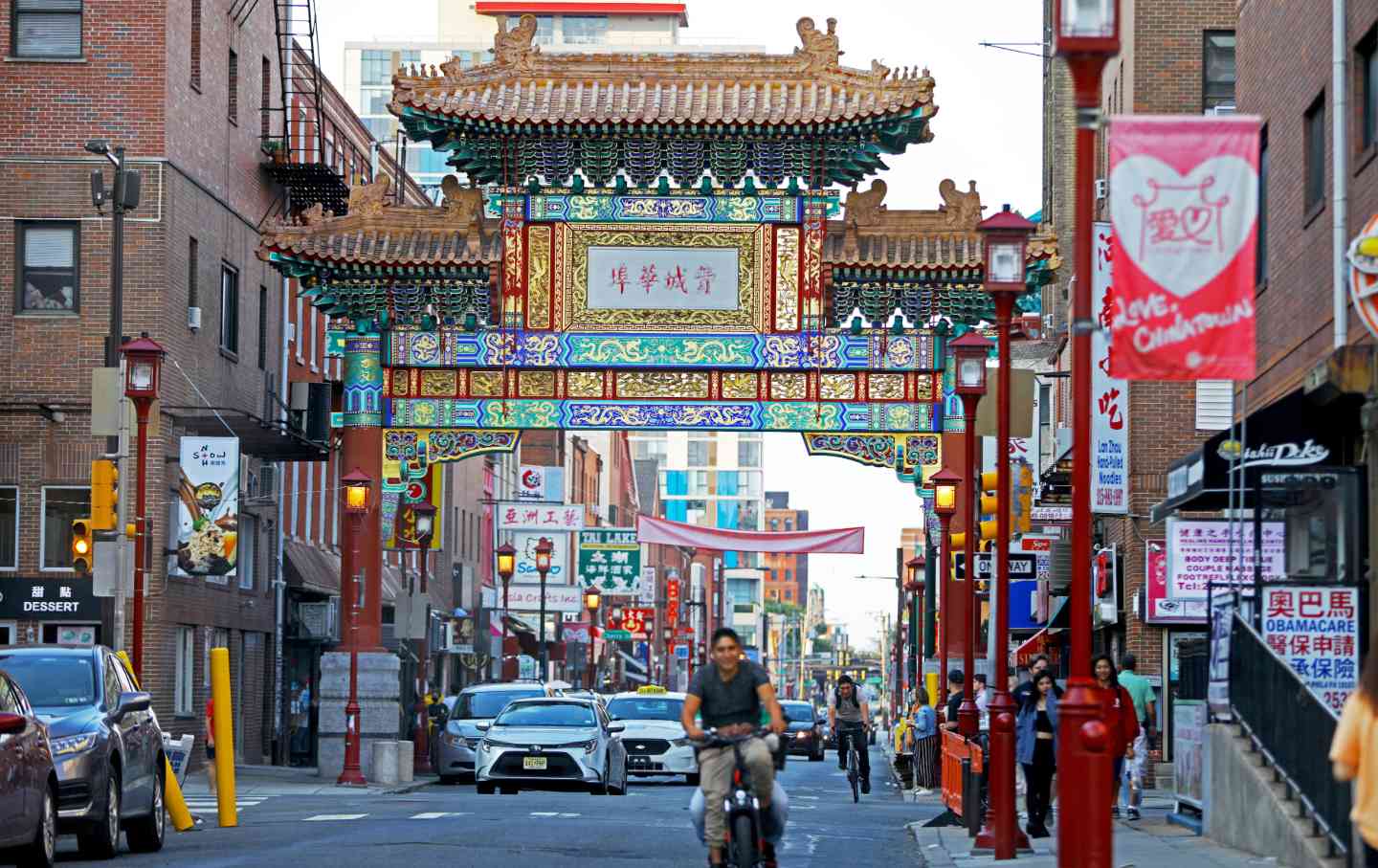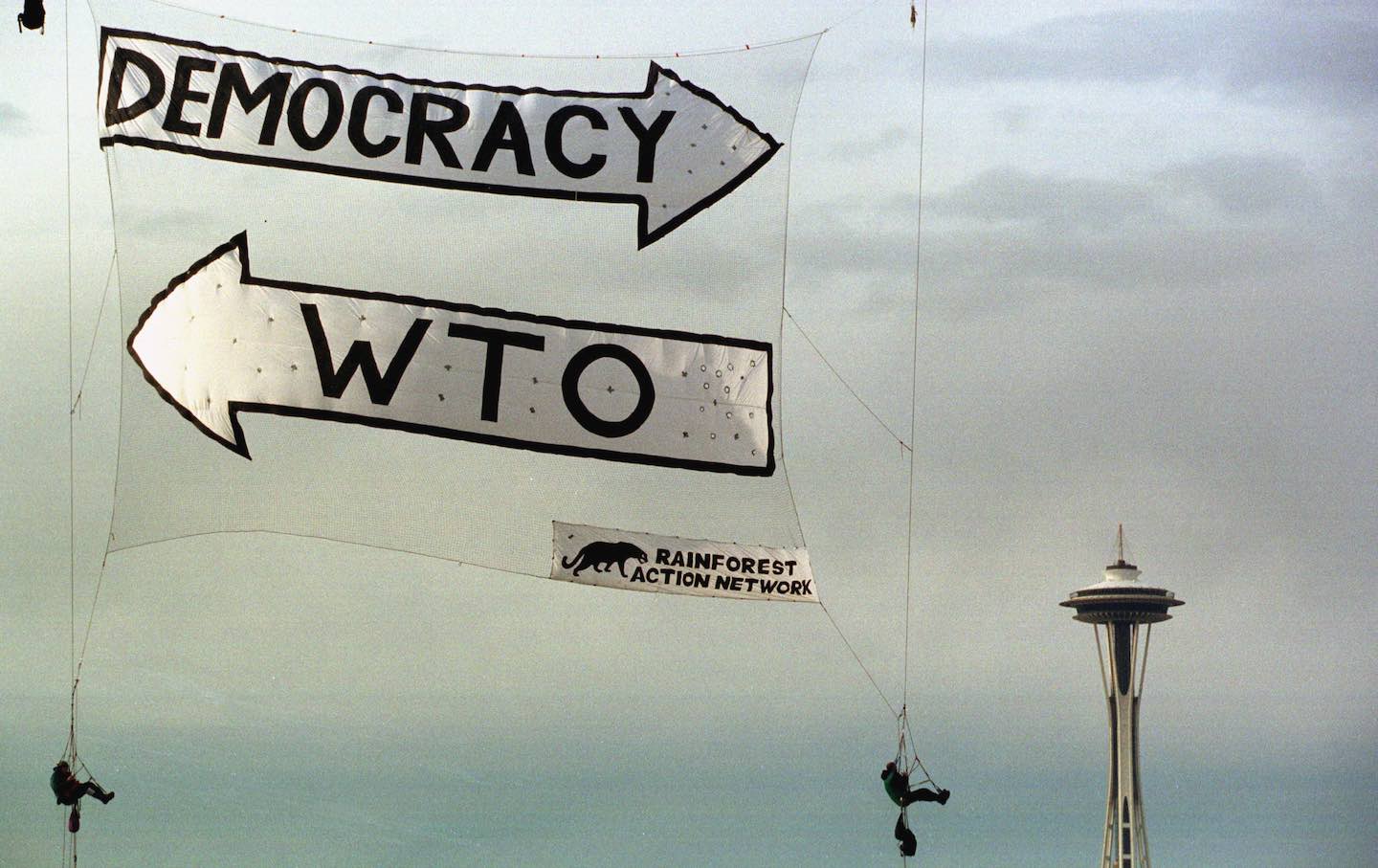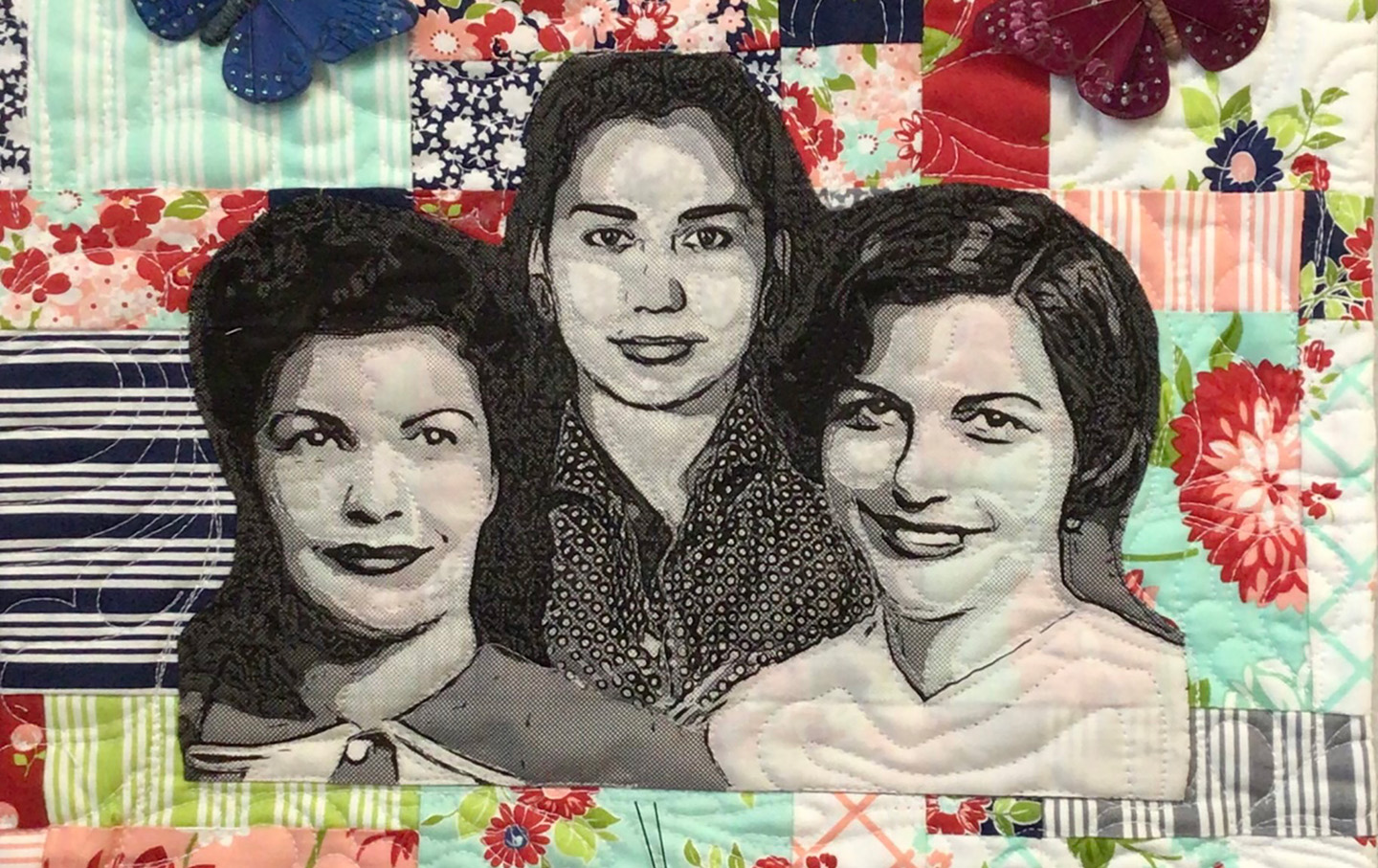The Long, Wild, Bloody History of the Hollywood Strike
Today’s strikes are part of a nearly century-long tradition within the entertainment industry.

Pickets march between rows of watchful police during the biggest demonstration yet staged by the Conference of Studio Unions, at Columbia Studios, on October 26, 1946.
(Dick Strobel / AP)Somewhere in its archives, the Screen Actors Guild holds a letter from Dracula. Already typecast as an aristocratic villain by 1938, Bela Lugosi had become desperate for steadier work. “I do not find it democratic,” he wrote the Guild’s executive secretary, “to put 50 percent of our actors on a yearly contract—providing them and their families abundantly with food and shelter, while the other 50 percent, just as good actors, have to go with their families to the gutter.” Lugosi sans fangs was a man of the left, driven from his native Hungary by a failed revolution rather than angry villagers. He proposed that jobless actors and crew should make films together, with the American Federation of Labor distributing everything: a socialist cinema of B-movies. Lugosi received sympathy, but no interest.
For character actors, or anyone else counted as minor expenses, the entertainment unions promised an alternative to their industry’s ruthless calculations of rank and prestige. Lugosi’s fellow bogeyman Boris Karloff was a founding member of the Screen Actors Guild, radicalized by the tortuous experience shooting Frankenstein, where he once spent 25 straight hours as a painted corpse. The lucky performers ended up bound to a single domineering studio, smothered by gold; the rest had to eke out whatever cameos or rewrite gigs they could. That classical system and its seigneurial contracts no longer exist, but Hollywood still funds spectacle with exploitation. One of the most unionized sectors in America, it has also become steadily proletarianized, and over last summer a new class consciousness emerged.
On May 2, 11,500 members of the Writers Guild of America (WGA) walked out, shutting down most film and TV production; nearly half of those authors were earning only the minimum weekly compensation laid out by their expiring agreement, up from 33 percent at that bottom rung in 2014. The streaming services that now lounge atop the industry have eaten away at residual payments, refusing to reveal how many people watch each offering. They hired ever-smaller staffs for the same amount of work—not a writer’s room so much as an oubliette. When subscriptions couldn’t yield enough profit to placate Wall Street, these companies bled it from the workers.
Familiar names help draw eyes to a picket sign, but the typical writer or actor carries slogans around anonymously, worrying about health insurance. Their class position is closer to a carpenter than to the stars. Past Hollywood strikes often struggled to transcend conservative, craft-based unionism and act collectively. Extras spent decades stranded outside those alliances, treated as an awkward philosophical question: Were they fellow artists, or something more technical? The WGA campaign used labor categories like a captured weapon. It gave many different workers the affinity of a single enemy.
The antagonists weren’t always so obvious. In 1945, a boxer-turned-painter named Herb Sorrell led his upstart Conference of Studio Unions (CSU) out on strike, aiming to enlist the skilled trades already represented by the International Alliance of Theatrical Stage Employees (IATSE). A Los Angeles labor council described the IATSE of that era as “a company union and a scab-herding agency.” Its local chapters bridled under the control of Mafia satraps, and studio bosses paid them off to negotiate nothing. CSU’s campaign threatened to complicate this happy arrangement. At one point, the leftist screenwriter John Wexley encountered Jack Warner in a steam bath. Quite literally red and nude, the mogul barked: “I saw you on that goddamn picket line. Stop striking. Fuck off!”
The bosses enjoyed an ally in the LAPD, whose Red Squad infested any vaguely progressive organization with spies and moles. Many cops also performed skull-bashing freelance work at the studio gates; one tear gas–streaked melee became known as “Black Friday.” The lines about a Communist conspiracy were already being rehearsed, even though the party initially opposed a strike. Gerald Horne’s intricate history of the period, Class Struggle in Hollywood, 1930-1950, quotes a popular newspaper columnist: “Sometimes the comrades despatch their be-sweatered cigarette girls with hot coffee and glamor to approach the pickets.… Sometimes the leftwingers use a slick jive band and female hep-cat comrades to attract the strikers to regular Communist dances.” Sometimes those women hurled their coffee over the police. It took what was then the largest mass arrest in California’s history to finally quash the CSU.
Sorrell’s speeches landed better than his tactics, and he alienated other Hollywood unions who might have been won over, but they also remained ambivalent out of fear. Soon the Screen Actors Guild and Screen Writers Guild (the future WGA) would dutifully give up their own members to the blacklist, receiving little in return except the political career of Ronald Reagan. He entered the SAG’s leadership ranks calling himself a “New Deal Democrat,” untroubled by his other identity as a government informer. Reagan knew how to tell a plausible-sounding fable, and in his story betrayal became conversion: the saintly scab.
It’s hard to picture a bloodless nonentity like Warner Bros. Discovery CEO David Zaslav calling up hired goons. The modern studios planned to divide and rule Hollywood’s workers with PR firms instead. In an article that backfired instantly, one executive confided to Deadline: “The endgame is to allow things to drag on until union members start losing their apartments and losing their houses.” That was why they quickly moved to settle a new contract with the Directors Guild, always the most management-friendly union. But shortly after that unnamed sociopath spoke about the “cruel but necessary evil” of immiserating writers, SAG-AFTRA joined the WGA on strike. Workers from the Teamsters, IATSE, and other below-the-line crews honored picket lines. And on September 24, the studios surrendered, agreeing to a deal that satisfied all the WGA’s priorities, from data transparency to staff minimums. Class solidarity forgotten, CEOs once again fantasized about gouging out each other’s eyes.
Back in May, I tagged along to one of New York’s first WGA pickets with other National Writers Union members. Scabby the Rat swayed rakishly in the breeze as we marched around Netflix headquarters. From a passing car, somebody yelled out, “AI is evil!”
The studios were listening, it turned out. When the WGA proposed regulating artificial intelligence, management countered with “annual meetings to discuss advancements in technology.” Hollywood producers have always treated screenwriters as an annoying necessity; what an exciting innovation it would be to make those sensitive artists revise some chatbot’s story outline uncredited, or feed their words to a language model. The new deal makes clear that, if bosses want derivative text, they’ll pay for it: “The Companies agree that because neither traditional AI nor [generative] AI is a person, neither is a ‘writer’ or ‘professional writer’.… written material produced by traditional AI or GAI shall not be considered literary material.”
SAG-AFTRA’s 160,000 members remain on strike, even more unnerved by AI. Automatons can’t create anything, but they might simulate an actor’s likeness convincingly enough, with audiences inured to murky computer graphics. According to Duncan Crabtree-Ireland, SAG-AFTRA’s chief negotiator, the studios offered a single day’s pay to scan a performer’s image and manipulate it at will. A consent form would of course be required. In her book Below the Stars: How the Labor of Working Actors and Extras Shapes Media Production, the academic Kate Fortmueller argues that residual payments will always be a defensive measure, straining to catch up with new technology, because they cede ownership to somebody else. The negotiations never end. Imagine arguing for a share of the profits from your counterfeited face.
I must admit that AI-generated imagery would be the perfect house style for Netflix et al.: busy yet empty, an approximation of art. As the strike went on, more and more writers suggested that the streaming glut brought poisonous effects. Hollywood studios have merged production and distribution to a symmetry unseen since the 1940s Paramount Decrees, which abolished their monopoly over the theater chains. “I think we’re really scraping the bottom of the barrel with the IP boom,” the writer-director Cord Jefferson said in an interview. “I remember reading about these guys who were trying to break Fruit Ninja, which, that’s just a disembodied hand chopping fruit, and they were trying to figure out how to make a Fruit Ninja movie.”
Popular
“swipe left below to view more authors”Swipe →Strikes allow workers to rule themselves, briefly unbothered by capital’s demands. In that militant atmosphere, some of them asked: Why does this system produce so many things so badly?
“[Strikes] show the working class who are the protagonists in the story of our lives,” The Bear writer Alex O’Keefe told Jacobin. “That’s my idea of what a union can be. It’s not simply every three years fighting for raises, but an organizing entity for the people in an occupation to find a home.” Next year, both IATSE and the Teamsters’s Motion Picture Division will be fighting out another contract, and WGA members have promised to return their solidarity. But a wider battleground is becoming visible. How can the movement break through to visual-effects shops, which effectively assemble much of film and TV over cruelly endless shifts? What would it look like for writers and actors to stand alongside Hollywood’s caterers or its hotel staff?
In 1919, the Hungarian theatrical union that Bela Lugosi cofounded began publishing a journal, where he wrote: “After putting aside the glamorous trappings of his trade at the end of each performance, an actor had, with few exceptions, to face worry and poverty.… Martyrdom was the price of enthusiasm for acting.” As the counterrevolutionary government tortured and imprisoned leftists, Lugosi fled, made his way to a colony of other exiles, and discovered that capitalism had subtler humiliations awaiting him. Sometimes I imagine an alternate history where the entertainment unions were not so reactive, no longer consumed by arbitrary craft distinctions or terrified of red-baiting, where they put money behind Lugosi’s dream of collective filmmaking. And following last summer’s strikes, I wonder about a contrapuntal revival of labor cinema: Madeline Anderson walking the picket line with South Carolina nurses, Chris Marker lending his camera equipment to French factory workers. The auteur yielding to the ensemble.
“Here is what happened,” my friend Kathryn Borel told me recently. A WGA strike captain, she had just organized an Anne of Green Gables–themed picket line, inspired by her last screenwriting credit. “We were all in our own personal hells. Then we went on strike. Then we realized we were in the same hell but we couldn’t see over the walls they’d created to make us feel alone. Now we’re together, and we know we have a common purpose, and so things will change, for a while at least, until the bad guys try again with a new weapon. And so it goes forever.”
More from The Nation

Yale Students Voted to Divest, but What’s Next is Unclear Yale Students Voted to Divest, but What’s Next is Unclear
The referendum calls on the school to divest its $41 billion endowment from military weapons manufacturing firms, yet the power to do so is in the hands of the board of trustees.

The “Save Chinatown” Coalition Goes on the Defensive in Philadelphia The “Save Chinatown” Coalition Goes on the Defensive in Philadelphia
The construction of a new basketball arena threatens to fill the neighborhood with more traffic and raise rents.

Human Rights for Everyone Human Rights for Everyone
December 10 is Human Rights Day, commemorating the anniversary of the Universal Declaration of Human Rights (UDHR), one of the world's most groundbreaking global pledges.

25 Years Ago, the Battle of Seattle Showed Us What Democracy Looks Like 25 Years Ago, the Battle of Seattle Showed Us What Democracy Looks Like
The protests against the WTO Conference in 1999 were short-lived. But their legacy has reverberated through American political life ever since.

Hollywood’s Vocal Actors Union Goes Silent on a Gaza Ceasefire Hollywood’s Vocal Actors Union Goes Silent on a Gaza Ceasefire
Amin El Gamal, head of SAG-AFTRA's committee on Middle Eastern and North African members, has advocated for a statement supporting a ceasefire in Gaza—so far without success

The Mirabal Sisters The Mirabal Sisters
Patria, Minerva, and María Teresa Mirabal were sisters from the Dominican Republic who opposed the dictatorship of Rafael Trujillo; they were assassinated on November 25, 1960, und...


